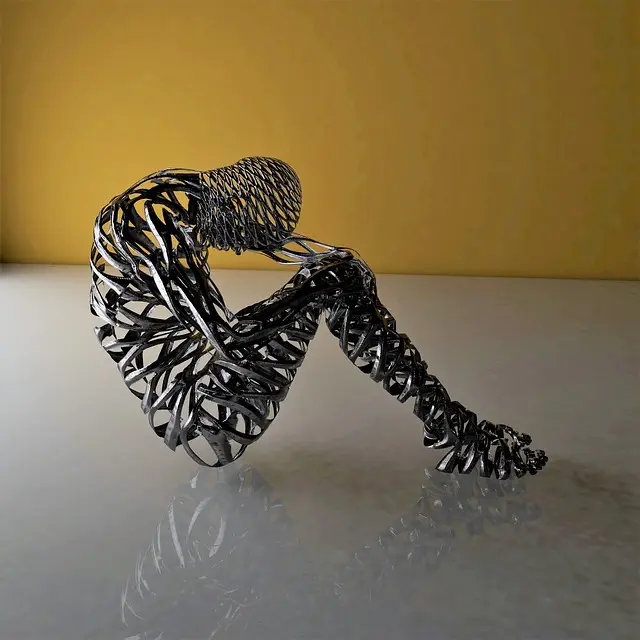Kratom, derived from Mitragyna speciosa leaves, has been identified as a potential aid for individuals with anxiety disorders, offering muscle relaxation that can alleviate physical symptoms associated with anxiety-induced tension. Its efficacy in this regard is under scientific scrutiny, with ongoing research examining its anxiolytic properties and safety profile. While kratom may provide relief, it should be used cautiously and under the guidance of healthcare professionals due to varying legal statuses and potential side effects. A balanced treatment approach includes integrating kratom with evidence-based therapies, lifestyle changes like regular exercise, and other medications as part of a comprehensive plan. This holistic strategy, which encompasses professional care, complementary therapies, and a nutritious diet, aims to improve well-being and quality of life for those managing anxiety disorders by addressing both the physical and mental health aspects.
Anxiety disorders significantly impact the daily lives of millions worldwide, often accompanied by heightened stress and muscle tension. This article delves into the multifaceted support available for those navigating these challenges, with a particular focus on the role of Kratom in managing anxiety and promoting muscle relaxation. We explore how Kratom can be integrated into comprehensive support systems that include therapeutic practices and professional guidance. Furthermore, we examine holistic approaches to anxiety management, highlighting the benefits of combining Kratom with exercise, mindfulness, and nutrition for enhanced muscle relaxation and emotional well-being. Join us as we unravel the complexities of anxiety disorders and shed light on how Kratom may offer relief, ultimately enriching the support landscape for those in need.
- Understanding Anxiety Disorders: The Role of Kratom in Managing Anxiety and Promoting Muscle Relaxation
- Navigating Support Systems for Anxiety Disorders: Integrating Kratom with Therapeutic Practices and Professional Guidance
- Holistic Approaches to Anxiety Management: Combining Kratom with Exercise, Mindfulness, and Nutrition for Muscle Relaxation and Emotional Well-being
Understanding Anxiety Disorders: The Role of Kratom in Managing Anxiety and Promoting Muscle Relaxation

Anxiety disorders encompass a spectrum of conditions characterized by persistent and excessive worry, fear, or anxiety that interferes with daily functioning. A comprehensive understanding of these disorders is crucial for effective management and treatment. Among various approaches, Kratom has garnered attention for its potential role in alleviating symptoms associated with anxiety and promoting muscle relaxation. Kratom, derived from the leaves of Mitragyna speciosa, contains alkaloids that interact with the brain’s opioid receptors, which can influence mood and pain perception. For individuals experiencing muscle tension as a component of their anxiety, Kratom may offer a beneficial effect through its muscle-relaxing properties. The alkaloid 7-hydroxymitragynine is particularly noteworthy for its analgesic qualities, contributing to the physical relaxation often sought by those managing anxiety.
It’s important for individuals considering Kratom as a supplementary aid in their anxiety management strategy to consult healthcare professionals. This is because the effects of Kratom can vary greatly depending on dosage, strain, and individual physiology. Additionally, while Kratom may offer muscle relaxation benefits, its use should be cautious and well-informed due to potential side effects and its regulatory status in various regions. Understanding the nuanced relationship between Kratom and its impact on anxiety relief and muscle relaxation is a complex and evolving area of research, with ongoing studies needed to fully elucidate its efficacy and safety profile. As such, while Kratom holds promise for those suffering from anxiety disorders, it should be one component within a comprehensive treatment plan that includes therapy, lifestyle adjustments, and possibly other pharmacological interventions under the guidance of medical experts.
Navigating Support Systems for Anxiety Disorders: Integrating Kratom with Therapeutic Practices and Professional Guidance

Individuals grappling with anxiety disorders often seek multifaceted approaches to manage their symptoms effectively. Among the various strategies, Kratom has emerged as a potential natural supplement for those looking to alleviate anxiety and induce muscle relaxation. Kratom, derived from the leaves of Mitragyna speciosa, interacts with the brain’s opioid receptors, which can lead to anxiolytic effects. For some, it provides a sense of calm and relaxation in the muscles, helping to mitigate the physical manifestations of anxiety.
However, it is crucial to integrate Kratom use within a comprehensive support system that includes therapeutic practices and professional guidance. Consulting healthcare providers before incorporating Kratom into one’s regimen is essential to avoid potential interactions with medications and to determine appropriate dosages. Professional mental health practitioners can assist in tailoring a treatment plan that may include cognitive-behavioral therapy, stress management techniques, and other evidence-based interventions alongside the use of Kratom for muscle relaxation. This collaborative approach ensures a personalized and holistic path toward anxiety disorder management, promoting overall well-being and a better quality of life.
Holistic Approaches to Anxiety Management: Combining Kratom with Exercise, Mindfulness, and Nutrition for Muscle Relaxation and Emotional Well-being

Holistic approaches to managing anxiety often involve a combination of strategies that address both the physical and mental aspects of the condition. Kratom, derived from the Mitragyna speciosa tree, has gained attention for its potential role in anxiety disorders support. When used responsibly and under professional guidance, kratom can contribute to muscle relaxation, which is crucial for those experiencing tension-related symptoms of anxiety. Muscle tightness and discomfort can exacerbate feelings of distress, so alleviating this physical component through natural means like kratom can have a positive impact on overall emotional well-being.
Incorporating exercise into one’s routine is another key element in holistic anxiety management. Physical activity stimulates the production of endorphins, which are the body’s natural mood elevators, and can provide a sense of accomplishment and self-efficacy. Pairing kratom with regular, moderate exercise not only promotes muscle relaxation but also helps to regulate mood and reduce anxiety symptoms. Additionally, mindfulness practices such as meditation, deep breathing exercises, and yoga complement the physical aspect by fostering mental clarity and emotional stability. Coupled with a balanced diet that includes nutrients known to support mental health—like omega-3 fatty acids, B vitamins, magnesium, and antioxidants—these holistic strategies can synergistically work towards managing anxiety and enhancing one’s quality of life.
In conclusion, anxiety disorders can present significant challenges in daily life, but understanding their nature and exploring integrative approaches such as the potential role of Kratom in managing anxiety and promoting muscle relaxation provides a multifaceted support system. By combining Kratom’s effects with therapeutic practices and professional guidance, individuals can navigate their journey towards emotional well-being more effectively. Additionally, holistic strategies that include exercise, mindfulness, and balanced nutrition further enhance the benefits of Kratom for muscle relaxation. It is through these comprehensive and personalized approaches that those affected by anxiety disorders may find greater support and improved quality of life.






